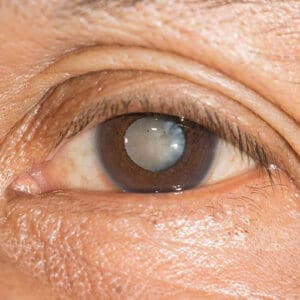Cataract Surgery
Premium Laser Assisted Cataract Surgery

At the Cornea and Laser Eye Institute, we use our same approach for cataract surgery as we do for LASIK. Just like LASIK, cataract surgery is a refractive vision correcting procedure. With modern premium intraocular lens implants (IOLs), cataract surgery is an opportunity to minimize and sometimes eliminate your need for glasses correction. Given our years of experience and innovation in LASIK, we incorporate the same techniques, advanced ocular examination, and experience with your cataract surgery to achieve exceptional results. Contact us to schedule a complimentary cataract evaluation, and our doctors will discuss a specific plan for your personal visual needs.
What does Cataract surgery treat?
- Farsighted
- Reading
- Astigmatism
- Nearsighted
What is a Cataract?

A cataract is a clouding of the natural lens in your eye as you age. The natural crystalline lens is normally clear. As a cataract develops, the lens becomes more cloudy, yellow, and opacified, blocking light and a clear image from entering the eye. A cataract is painless and develops over time, causing progressive loss of vision.
When is Cataract Surgery Needed?
Cataract surgery is generally an elective procedure. If your vision is good enough to drive safely, read, and perform your normal day-to-day activities, surgery may not be needed right away.
Cataract surgery will not correct other causes of decreased vision, such as glaucoma, diabetes, or age-related macular degeneration.
The Cataract Procedure
At the Cornea and Laser Eye Institute, we offer femtosecond laser-assisted cataract surgery, the latest innovation in the technique. Cataract surgery should be entirely comfortable for you. Though you are awake during the procedure, your eye is numbed with drops.
During cataract surgery, a small incision is first made in the cornea. The lens is then removed by a process called phacoemulsification, whereby an ultrasound device allows the lens material to be gently aspirated by suction thru the small entry port. A permanent intraocular lens implant is placed inside the eye, and the incision is generally closed without any stitches.
Femtosecond Laser Assisted Cataract Surgery (FLACS)
The laser used is called a femtosecond laser. This type of laser uses ultra-short laser pulses to prepare the eye for cataract surgery. A similar laser is used during LASIK to create the LASIK flap. The femtosecond laser may be used to assist in certain portions of your cataract surgery. This laser adds precision to the incisions made during cataract surgery, may help to improve the positioning of your implants, and assists in softening the lens before ultrasound removal. In certain cases, the femtosecond laser will be used for the correction of your corneal astigmatism as well.
Cataract surgery at The Cornea and Laser Eye Institute is performed in a same-day ambulatory surgery facility.
After surgery, your eye will be covered by a clear eye shield (some patients may require an eye patch after surgery). Most patients will begin to use their eyedrops immediately after the procedure. Vision should improve soon after surgery but may fluctuate for a week or two. We will see you back for follow-up during this time period, as well as 1 month and 3 months after surgery.
Side Effects & Correcting Vision after Cataract Surgery
We strive for exceptional vision correction for all of our patients. Sometimes additional vision correction may be helpful after your cataract surgery. That is why we offer programs that include laser “touch-ups” (LASIK and PRK) to fine-tune your vision after your cataract procedure. LASIK or PRK “touch ups” will be performed at our in office surgery suite. These are options that we will discuss when we see you for your cataract evaluation. Though rare, there may also be medical complications after cataract surgery. These include visual side effects such as glare and halo around lights at night, posterior capsular opacification, glaucoma, corneal swelling, rupture of the lens capsule, and retinal detachment. Although rare, these and other possible side effects will be discussed with you in detail.
Intraocular Lens Implant Designs
Monofocal Implants
These are meant to achieve clear focus at distance vision. Often, we will use a blended vision approach in which one eye is set for distance and the other eye is set closer to the near point to help with some near vision tasks.
Extended depth of focus IOLs
These IOLs extend the range of the distance focal point to improve distance and intermediate (computer vision). You may require some reading glasses for near tasks, but these lenses provide an excellent quality of vision and may have less halo and glare around lights at night.
Multifocal Implants
These IOLs improve near vision in addition to distance vision. Some patients may find that distance vision is not as crisp as with a monofocal lens. Also, some patients will notice halo or glare around lights at night. New models of these lenses may give even better results.
Trifocal implants
These IOLs are the newest implant for correction of distance, intermediate, and near vision. Although this lens has similar limitations to the multifocal implants (as above), these lenses provide improved vision for distance, computer, and reading tasks.
Astigmatism-Correcting (Toric) Implants
All of the above IOLs have an astigmatism correcting option. These IOLS are helpful in patients with astigmatism, in order to achieve uncorrected vision without glasses.
Which lens is best for you and what to expect from the different lens designs:
| Distance | Computer | Reading | Option to Correct Astigmatism | |
| Monofocal | ● | ○ | ○ | Yes |
| Blended Vision | ◕ | ◑ | ◑ | Yes |
| Extended Depth of Focus | ◕ | ◕ | ◑ | Yes |
| Multifocal | ◕ | ◑ | ◕ | Yes |
| Trifocal | ◕ | ◕ | ◕ | Yes |
◔ Minimal Correction Expected
◑ Moderate Correction Expected
◕ May Be Less Clear Than Monofocal Lens
● Full Correction





